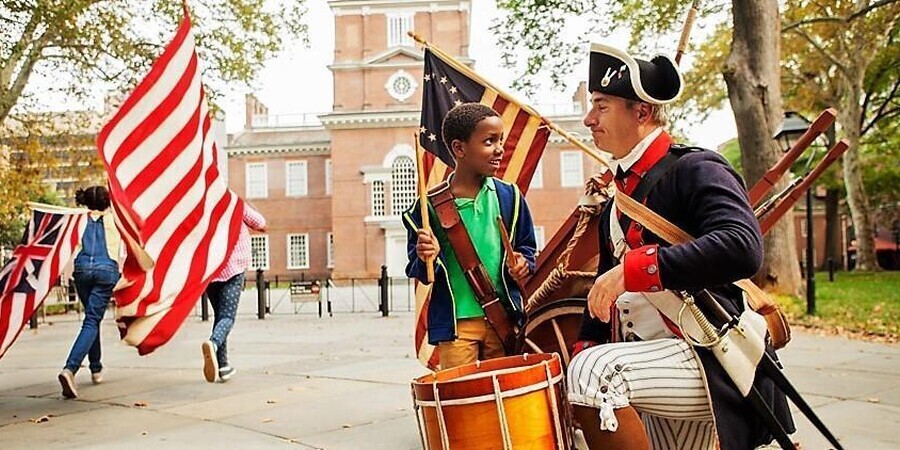Philadelphia Historic Timeline -
1683: William Penn publishes the plan for the City of Philadelphia, as designed by Thomas Holme. The map features a grid of streets, plus five squares or public green spaces. This grid survives today. Named streets run north or south. Numbered streets run east or west. Penn’s squares survive too: Rittenhouse, Logan (now Logan Circle), Center (now City Hall and Dilworth Park), Washington Square, between 6th and 7th Streets and Walnut and Spruce Streets, and Franklin Square, between 6th and 7th Streets and Race and Vine Streets.
1683: William Penn's Vision Shapes Philadelphia's Grid and Welcomes Germantown's First Settlers
The year 1683 marked a foundational period in the nascent colony of Pennsylvania, heavily influenced by the vision of its founder, William Penn. During this pivotal year, the ambitious plan for the city of Philadelphia was officially published, laying out an enduring urban design, while Penn's promise of religious freedom began to attract diverse groups, leading to the establishment of the pioneering German Township.
Penn's "Greene Countrie Towne": Philadelphia's Enduring Blueprint
In 1683, William Penn formally presented his plan for Philadelphia, a design conceived by his surveyor, Captain Thomas Holme. This visionary blueprint was intended to create a "greene countrie towne," blending urban living with ample open space, a departure from the crowded cities of Europe.
- The Grid System: The most defining feature of Holme's plan was its orderly grid of streets. This rational layout, with wide, straight avenues, was designed for easy navigation, public health, and to prevent the kind of devastating fires that had plagued London. This original grid remains the core of Center City Philadelphia today.
- Street Naming Convention: The plan established a logical system for street names that largely persists: named streets (like Chestnut, Walnut, Arch, Race, Pine) were designated to run north to south, while numbered streets (Front, Second, Third, etc.) were laid out to run east to west from the Delaware River.
- Five Public Squares: A hallmark of Penn's design was the inclusion of five public green spaces, intended for common use, recreation, and to ensure the city remained airy. These squares, though some have evolved, still exist today:
- Centre Square: Now the site of Philadelphia's magnificent City Hall and the surrounding Dilworth Park.
- Rittenhouse Square: A fashionable and beloved park in Southwest Center City.
- Logan Square (now Logan Circle): A prominent civic space on the Benjamin Franklin Parkway, featuring the Swann Memorial Fountain.
- Washington Square: Located between 6th and 7th Streets, and Walnut and Spruce Streets, this historic square also served as a burial ground.
- Franklin Square: Situated between 6th and 7th Streets, and Race and Vine Streets, now a vibrant family-friendly park with a carousel and mini-golf.
A Haven for Conscience: The Founding of German Township
William Penn's commitment to religious tolerance was a cornerstone of his vision for Pennsylvania, attracting diverse groups seeking refuge from persecution in Europe. In 1683, this promise bore significant fruit:
- First German Settlers: Thirteen German families, primarily Mennonites and Quakers from the Krefeld region of Germany, responded to Penn's invitation.
- Establishment of German Township: These settlers established the German Township (Das Deutschestädt), located northwest of the burgeoning city of Philadelphia. This area would later become known as Germantown, one of Philadelphia's most historic neighborhoods.
- Early Anti-Slavery Sentiment: Germantown would also become notable as the site of the first organized protest against slavery in the American colonies, the 1688 Germantown Quaker Petition Against Slavery.
The year 1683 was instrumental in shaping the future of both Philadelphia and Pennsylvania. William Penn's and Thomas Holme's thoughtful urban plan provided Philadelphia with an enduring grid and cherished public squares that define its character to this day. Simultaneously, the arrival of German Mennonite and Quaker families in response to Penn's promise of religious freedom marked the beginning of Pennsylvania's rich tradition as a diverse and welcoming haven, leading to the establishment of significant communities like Germantown. These foundational events underscore Penn's profound impact on creating a well-ordered and tolerant society.


